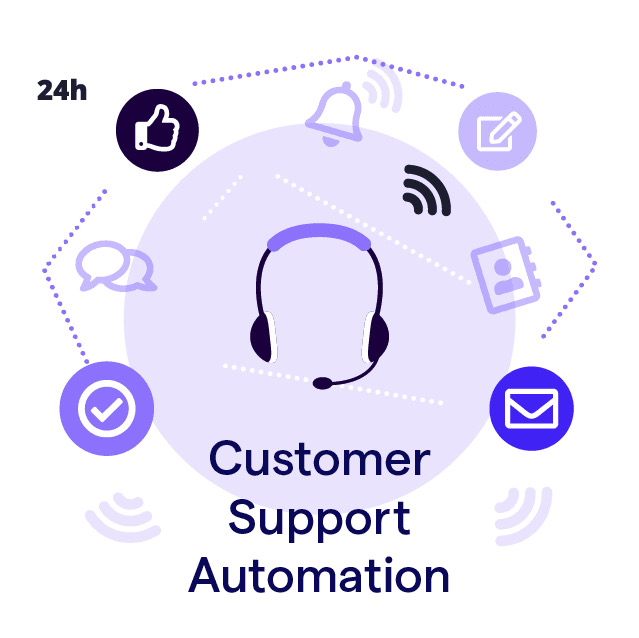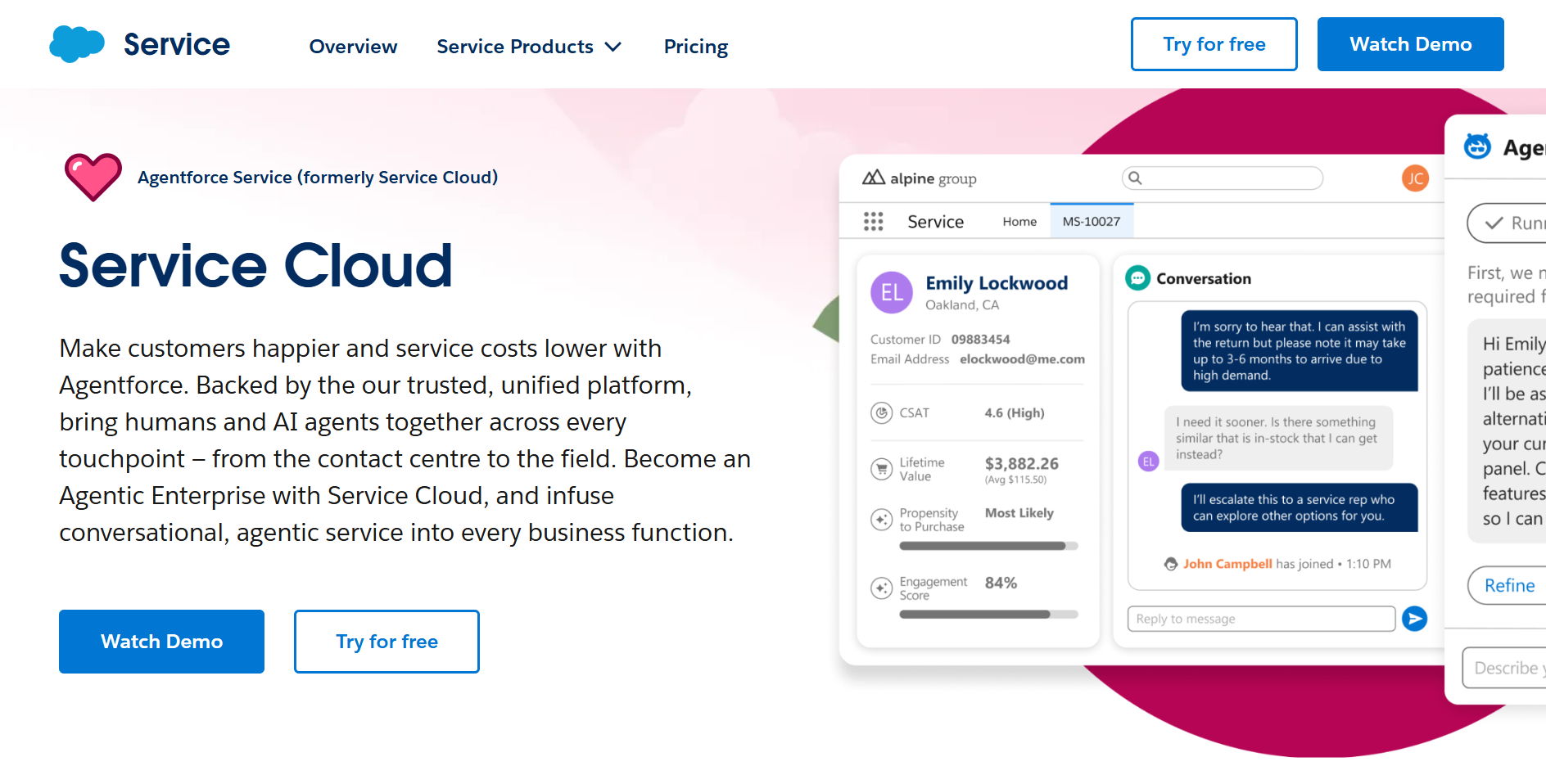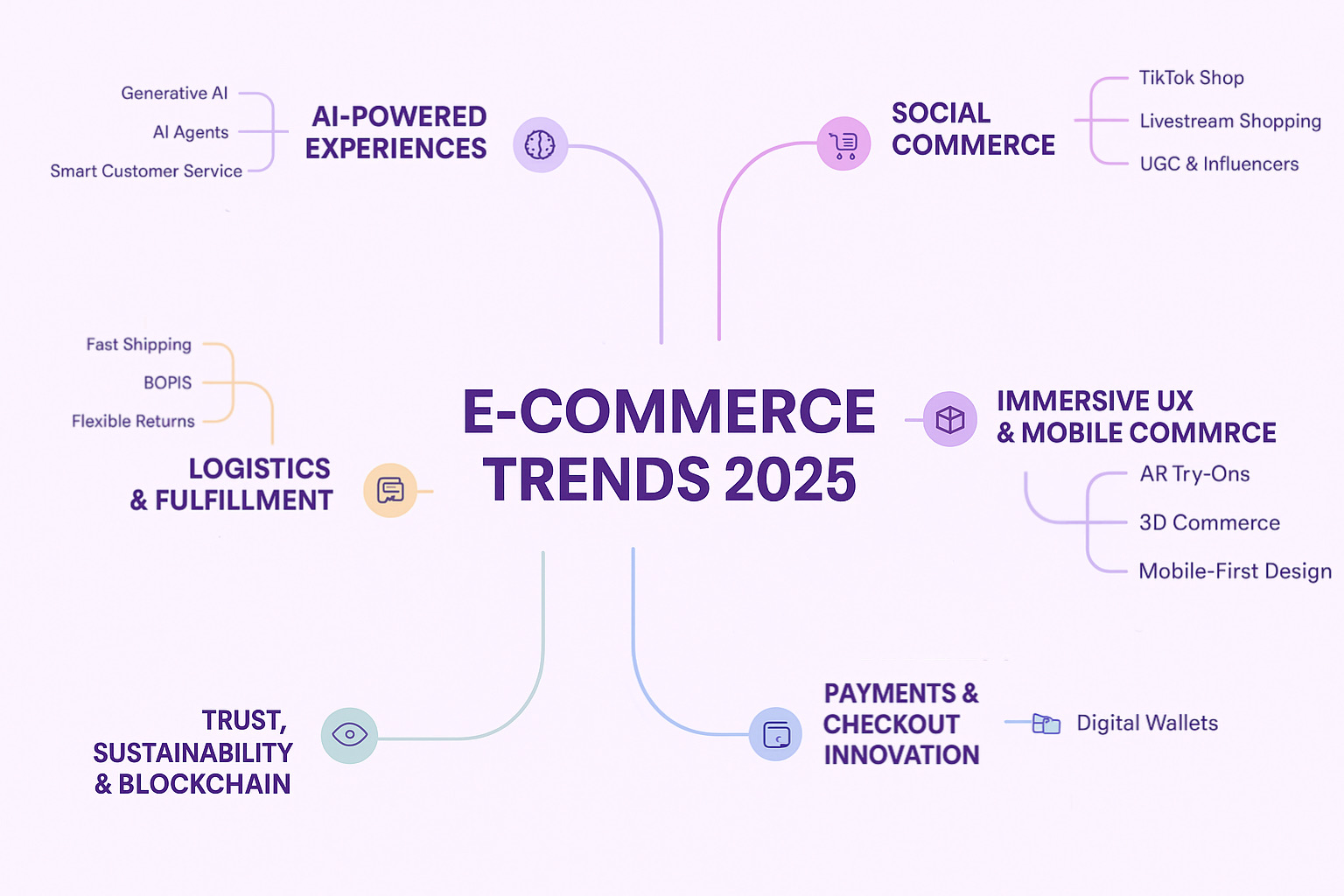Customer Support Automation: Benefits, Use Cases & Best Tools in 2025

We live in a fast-paced digital world, and customers expect instant, 24/7 support across every channel. That’s why more companies are turning to customer support automation - the use of AI and smart workflows to handle routine inquiries, reduce response times, and boost customer satisfaction. By automating repetitive tasks, businesses can focus their human agents on complex issues that actually require empathy and judgment, striking the perfect balance between efficiency and personal service.
90% of customers rate an “immediate” response as important or very important when they have a customer service question and 60% of customers define “immediate” as 10 minutes or less.
What Is Customer Support Automation (and How It Works)
Customer support automation refers to the process of using technology, particularly artificial intelligence (AI), machine learning (ML), and natural language processing (NLP), to enhance customer service operations. Instead of manually replying to every ticket or chat, automation allows businesses to resolve common issues automatically, such as password resets, order tracking, or appointment scheduling.
Here’s how it works in practice: when a customer submits a request through chat, email, or a contact form, an AI-powered system identifies the intent of the message. Based on pre-set rules or machine learning models, it can automatically route the ticket to the right department, trigger an instant response, or even resolve the issue entirely without human intervention.
Behind the scenes, customer support automation relies on several key components:
- Chatbots and virtual assistants that answer FAQs and guide users in real time.

- CRM integrations that pull up customer data to personalize each interaction.
Read more: 25 Best E-commerce Integrations and their benefits.
- Automated ticketing systems that categorize, prioritize, and assign requests efficiently.

- Analytics dashboards that track performance metrics like response time and satisfaction rate.
When implemented effectively, this system becomes an extension of your support team, always on, always learning, and always ready to help.
Benefits of Customer Support Automation
You can redefine the entire customer experience by implementing customer support automations. Businesses can use AI-driven workflows, automated chatbots, and smart ticket routing. This helps them improve efficiency, consistency, and customer satisfaction at the same time. Below are the key advantages every company can expect when it integrates automation into its support ecosystem.

- Faster Response Times: I'm sure you have also left a chat after you didn't get a response in a few seconds. Customer support automation enables instant responses to common questions through AI chatbots or automated email replies. Instead of waiting in a queue, customers receive real-time guidance, whether they’re asking about delivery updates, password resets, or billing details. Studies show that companies using automated response systems can reduce average response times by up to 80%, dramatically improving overall service quality and customer perception.
- 24/7 Availability: Human agents can’t be online around the clock, but automation never sleeps. With AI-powered support systems, your customers can get help anytime. This always-on customer service is especially valuable for global companies operating across time zones. Customers no longer have to adjust their schedules or wait until business hours to get assistance. Instead, automation ensures that support is always within reach, leading to higher satisfaction and trust in your brand.
- Cost Efficiency and Scalability: Hiring and training additional support agents can quickly become expensive as your business grows. Automation offers a scalable alternative. Once an automated workflow or chatbot is set up, it can handle thousands of interactions simultaneously without additional labor costs. For example, an e-commerce company can use automated support to process hundreds of refund or tracking requests daily, saving thousands in staffing costs. Over time, these efficiencies compound, reducing operational expenses while maintaining high service quality.
- Improved Consistency and Accuracy: Even the most experienced human agents can make mistakes or deliver inconsistent responses. Automated systems, however, follow predefined rules and trained AI models, ensuring that every customer receives accurate and consistent information. This consistency is critical for maintaining brand credibility. Whether a customer interacts via email, chat, or social media, the answers should remain uniform. Customer support automation guarantees that standard procedures and policies are communicated clearly every single time.
- Enhanced Agent Productivity: Automation should help your agents, not replace them. By taking over repetitive and low-value tasks (like logging tickets, tagging requests, or responding to FAQs), automation allows agents to focus on strategic, human-centric responsibilities such as problem solving, empathy, and customer retention. This not only increases productivity but also reduces burnout. As a result, your support team becomes more motivated, creative, and efficient.
- Data-Driven Insights and Continuous Improvement: Every automated interaction generates valuable data. Modern AI customer service systems track customer behavior, common issues, sentiment, and service performance metrics. This information helps companies identify pain points and optimize their support strategies. For instance, if automation detects that most customers ask about a specific product feature, your business can proactively address it in marketing or product design. This feedback loop turns your customer service system into a continuous learning engine.
- Multichannel Support: Customers today reach out through multiple platforms: email, social media, chat, and even voice assistants. Managing all of these manually is nearly impossible. Customer support automation tools integrate across these channels, centralizing conversations in one place and ensuring no request goes unanswered. A single dashboard can handle a customer’s Twitter message, website chat, and email inquiry.
Challenges of Customer Support Automation (and How to Overcome Them)
Even though customer support automation is transforming the way companies deliver customer service, it’s not without its challenges. Many organizations rush into automation without a clear strategy, resulting in frustrating experiences for both customers and the support team. The good news is that these challenges are avoidable when businesses understand what to look out for (and how to plan around them).
Below are five of the most common obstacles companies face when automating their customer service operations, along with practical solutions to overcome them.
1. Losing the Human Touch
A frequent mistake in automated customer service is relying too heavily on AI chatbots and virtual agents without maintaining a human connection. When customers face complex issues, overly scripted bots or IVR systems (interactive voice response) can make them feel unheard, damaging trust and overall Customer Satisfaction.
How to overcome it:
Use automation to enhance human interactions, not replace them. Combine AI agents with human customer service escalation paths. For example, automated flows can greet the user, collect key customer queries, and route them through ticketing systems to the right support agents using ticket routing rules. From there, a trained agent can step in when empathy or personalization is required.
When it comes to generative AI, 68% of non-users are Gen X or Baby Boomers. When asked, some top of mind negative word associations that the participants mentioned were “scary,” “safety and security risk,” “creepy,” “loss of control,” and a few more.
2. Poor AI Training
Without high-quality data, even advanced artificial intelligence and machine learning models can perform poorly. An untrained AI support bot might misunderstand intent, generate irrelevant answers, or create repetitive loops that frustrate users. Poor knowledge base content and a lack of structured data make this problem worse.
How to overcome it:
Feed your AI chatbots and automated ticketing systems with real customer feedback, chat logs, and CSAT survey responses. Update your knowledge base regularly with verified information from your support team and product documentation. The more accurate and diverse your training data is, the better your automation system will become at understanding natural language and improving response time.
AI can't say I don't know, so without enough data it will just take an educated guess, and that is what you want to avoid.
3. Integration Challenges with Existing Systems
Most organizations already rely on helpdesk tools, CRM systems, and workflow automation software. Adding a new layer of customer service automation can create integration challenges, especially when ticket management systems, self-service portals, and live chat tools don’t communicate properly. This leads to fragmented data, delayed response times, and frustrated support agents.
How to overcome it:
Before rolling out automation, map your support journey and ensure all tools (like your CRM, knowledge base, and ticketing system) share real-time data. Choose support automation tools that offer native integrations and open APIs. Unified systems ensure better workflow automation, collaboration across your customer support team, and customer experience across all channels.
4. Over-Automation
It’s tempting to automate every aspect of your customer service process, but excessive automation often backfires. Over-automated chat flows can confuse customers or make them feel trapped in endless loops without human help. When automation replaces empathy, customer relationships suffer, and so does your customer satisfaction score.
How to overcome it:
Start small. Use automation software to streamline repetitive tasks like password resets, order tracking, and ticket automation. Use AI-powered analytics dashboards to monitor where customers drop off in the support journey and adjust your automated flows accordingly.
A balanced mix of support automation and human assistance ensures efficiency without sacrificing the emotional side of customer experience.
Real-World Use Cases of Customer Support Automation
From retail giants to SaaS startups, businesses around the world are using customer support automation to enhance their customer service operations and deliver better customer experiences.
E-commerce: Amazon’s AI Chatbots and Automated Customer Service

Amazon has long been at the forefront of automated customer service, setting the gold standard for customer experience in the e-commerce industry. The company’s AI chatbots and virtual agents handle millions of customer queries daily, covering everything from order management to returns and refunds.
Banking: Bank of America’s “Erica” Virtual Agent
Bank of America’s Erica is one of the most recognizable AI-powered customer service chatbots in the finance sector. Integrated directly into the bank’s mobile app, Erica provides instant self-service capabilities, checking balances, scheduling payments, and analyzing spending patterns using predictive analytics.
For more complex financial questions, Erica automatically creates cases within the ticket management system and routes them to human support agents. This seamless support automation saves time for both customers and employees while improving the overall customer journey through personalized, data-driven insights.
SaaS: HubSpot’s Automated Ticketing Systems and Knowledge Base
HubSpot, a leader in CRM and marketing automation, uses customer service automation internally to manage its large customer base. Through automated ticketing systems, email autoresponders, and a robust knowledge base, HubSpot ensures that users can quickly resolve common issues without needing to contact support agents directly.
Travel & Hospitality: KLM’s Multi-Channel Support Automation

KLM Royal Dutch Airlines was one of the first airlines to integrate AI chatbots and social media automation into its customer service strategy. Through platforms like Messenger, WhatsApp, and Twitter, KLM’s bots provide real-time updates on flight status, check-in information, and boarding passes.
By reducing manual handling of thousands of daily messages, KLM has improved its response time by over 60%, proving that AI-powered customer service can coexist harmoniously with a human-first brand image.
Top 5 Customer Support Automation Tools in 2025
Now that we have gone through the basics, here are five of the best customer service automation tools in 2025, with insights into who they’re ideal for and when to avoid them.
1. Zoho Desk

Zoho Desk is an all-in-one customer service platform that makes workflow automation accessible to teams of any size. With its AI assistant Zia, automated ticket routing, and integrated Knowledge Base, Zoho helps support agents manage support tickets efficiently while maintaining a smooth customer experience.
Who it’s best for:
- Small to medium-sized businesses that want affordable, scalable customer support automation.
- Teams looking to centralize self-service portals, ticket management, and email autoresponders in one place.
When to avoid:
- Large enterprises that need deep CRM or predictive analytics integrations.
- Companies with complex multi-channel support requirements across voice, chat, and social media.
2. Salesforce Service Cloud

Salesforce Service Cloud is a powerhouse for AI-powered customer service and enterprise workflow automation. With Einstein AI, companies can use predictive analytics, case management, and automated triaging to deliver faster, more personalized customer experiences. Its analytics dashboards help leaders monitor CSAT surveys, customer satisfaction scores, and overall support performance in real time.
Who it’s best for:
- Enterprises and large organizations with complex customer service operations.
- Businesses that want to integrate automation into their CRM, marketing, and sales ecosystems for a complete customer journey view.
When to avoid:
- Smaller teams with limited technical resources or budget.
- Companies that don’t need advanced customization or AI-Powered Analytics.
3. Amio

Amio specializes in AI chatbots using generative AI and omnichannel support automation. Its conversational AI agents can manage customer queries from social media, email, or web chat from a single dashboard. Amio offersmultilingual chatbots, workflow automation software and real-time data insights to help support teams automate ticket routing and boost response time without losing the human touch.
Who it’s best for:
- Companies scaling their AI-powered customer support and looking to integrate automation across multiple communication channels.
- Teams that want a balance between AI chatbots and human customer service handoffs.
When to avoid:
- If you think I'm being biased here 😅
- Teams focused solely on traditional email-based support without chat or messaging channels.
4. LiveChat

LiveChat blends human customer service with AI automation to deliver real-time communication. It supports AI agents, chatbot integrations, and ticketing system workflows, making it ideal for businesses that rely heavily on conversational channels. Its intuitive dashboard and automation software integrations help reduce response times and improve customer satisfaction.
Who it’s best for:
- Customer-centric brands that value personalized support and want to automate FAQs or after-hours responses.
- Companies looking for multi-channel support with human-to-bot transitions.
When to avoid:
- Teams seeking deep backend workflow automation or CRM management features.
- Enterprises needing highly technical AI-native solutions or predictive analytics.
5. Freshdesk (by Freshworks)

Freshdesk offers one of the most comprehensive customer service automation suites available. With Freddy AI, automated ticketing systems, and built-in self-service portals, it helps teams manage everything from incident management to CSAT surveys. Its workflow automation features simplify ticket escalation, SLA monitoring, and support journey tracking.
Who it’s best for:
- Businesses that want an intuitive helpdesk tool with strong automation and AI Copilot support.
- Companies focusing on improving customer satisfaction and agent productivity through automation.
When to avoid:
- Highly customized enterprise setups that need deep data processing or custom analytics dashboards.
- Teams that prefer open-source or highly flexible API environments.
Conclusion
So as customer expectations continue to rise, customer service automation has evolved from a nice-to-have to a competitive necessity. When implemented thoughtfully, it empowers your support team to deliver faster responses, reduce manual work, and create a smoother, more personalized customer experience.
But the best results come from balance, combining the precision of AI chatbots and workflow automation with the empathy only humans can offer. Whether you’re using tools like Amio, or another software, automation should serve as a bridge between technology and genuine connection. And if you are unsure where to start, we are here to help!
Book a 30-minute session where we will find out how AI bot can help you decrease call center costs, increase online conversion, and improve customer experience.
Book a demo





